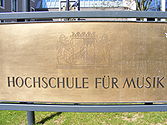University of Music Würzburg
| University of Music Würzburg | |
|---|---|

|
|
| founding | September 1, 1973 |
| Sponsorship | state |
| place | Wurzburg |
| state | Bavaria |
| country | Germany |
| president | Christoph Wünsch |
| Students | 600 (WS 2014/15) |
| Website | www.hfm-wuerzburg.de |
The University of Music Würzburg is a State Academy of Music in Würzburg.
In 1797, a Collegium musicum academicum was founded by Franz Joseph Fröhlich . From 1921 to August 1973 the Bavarian State Conservatory of Music arose from this , from which the Music Academy emerged on September 1, 1973; since 2001 it has been united with the (until then municipal) Hermann Zilcher Conservatory (the specialist academy ). The university is spread over three buildings in Würzburg: Hofstallstrasse 6–8, Ebracher Gasse 1 and Hofstrasse 13.
Christoph Wünsch has been President since 2017. The number of full students is around 600 (as of winter semester 2014/15).
courses
The following artistic (partly also artistic-pedagogical) courses lead to the “Bachelor of Music” degree:
The artistic and instrumental pedagogical subjects with a degree as a musician or music teacher are expiring and are no longer offered to new students.
Music studies are still offered in the artistic teaching post at grammar schools and in the artistic teaching post in elementary, middle and secondary schools.
There are also several postgraduate courses and the opportunity to do a doctorate.
Musically gifted children and young people receive specific support from the university (early musical education).
Concert hall organ
The organ in the concert hall was built in 2016 by the organ manufacturer Klais (Bonn) (an organ from the Öttingen company GF Steinmeyer & Co. was previously installed in the large hall of the music college ). The disposition was based on the original disposition of the Arnstadt Bach organ by Johann Friedrich Wender from 1703. However, it is not purely baroque, but enriched with registers from different epochs, so that the organ as a whole is a symphonic instrument. One of the special features of the instrument is the use of proportional magnets in playing technique. The instrument currently has 83 stops on three manuals and a pedal . So far, the stops of the fourth manual and some pedal stops have not been implemented. The instrument will have 106 registers in total. The playing and stop actions are electric.
|
|
|
|
|
|||||||||||||||||||||||||||||||||||||||||||||||||||||||||||||||||||||||||||||||||||||||||||||||||||||||||||||||||||||||||||||||||||||||||||||||||||||||||||||||||||||||||||||||||||||||||||||||||||||||||||||||||||||||||||||||||||||||||||||||||||||||||||||||||||||||||||||||||||||||||||||||||||||||||||||||||||||||||||||||||||||||||||||||||||||||||||||||||||||||||||||||||||||||||||||||||||||||
-
Couple
- Normal coupling: I / II, I / III, II / I, II / III, III / I, III / II, I / S, II / S, III / S, S / I, S / II, S / III, F / I, F / II, F / III, I / F, II / F, III / F, I / P, II / P, III / P, S / P, F / P
- Sub-octave coupling: I / I, II / II, III / III, S / S, F / F
- Super octave coupling: I / I, II / II, III / III, S / S, F / F, III / P
- Equal: I Equal Treble Ab, I Equal Bass Ab, II Equal Ab, III Equal Ab, SOLO Equal Ab, FERN Equal Ab
- Remarks:
- ↑ a b Swellable work.
- ↑ Full tongue register, in its own wind sill.
- ↑ Above the hall ceiling, swellable.
- ↑ In your own wind sill.
Well-known lecturers
- Franz Joseph Fröhlich (1780–1862), musicologist.
- Karl Muck (1859–1940), conductor
- Fritz Huth (1908–1980), horn player
- Bertold Hummel (1925–2002), composer
- Siegfried Fink (1928–2006), percussionist and composer
- Ernst Hoffmann (1928–2016), composer
- Peter Hollfelder (1930-2005), pianist
- Carl Joachim Ludwig (1931–1994), composer and conductor
- Martin Göß (1936–2018), trombonist
- Klaus Hinrich Stahmer (* 1941), composer and musicologist
- Heinz Winbeck (1946–2019), composer
Honors
Web links
- Official website
- Dieter Kirsch: University of Music, Würzburg . In: Historical Lexicon of Bavaria
Individual evidence
- ↑ https://www.hfm-wuerzburg.de/ueber-uns/geschichte
- ↑ University management. University of Music Würzburg, accessed on October 3, 2017 .
- ↑ Education and Culture. (PDF; 2 MB) Students at universities. Federal Statistical Office , p. 78 , accessed on November 4, 2015 .
- ↑ https://www.hfm-wuerzburg.de/ueber-uns/geschichte
- ↑ Description of the courses on the university website
- ↑ Klaus lens Meyer: The organs in Wurzburg churches. In: Josef Brecht, Gerhart Gradenegger (ed.): Friedrich-Koenig-Gymnasium Würzburg. Annual report 1979/80. Edited by the directorate of the Friedrich-Koenig-Gymnasium Würzburg. Würzburg 1980, pp. 112–120 ( Würzburg and his “Organ Landscape” ), pp. 117–119, here: p. 119.
- ↑ Information about the organ on the website of the organ builder
Coordinates: 49 ° 47 '32.9 " N , 9 ° 56' 2.2" E

